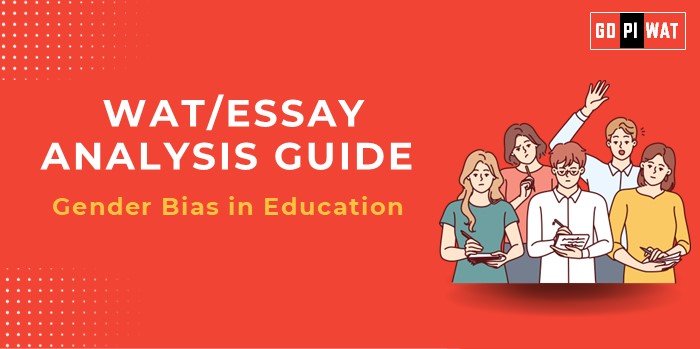📋 Gender Bias in Education – WAT/Essay Analysis Guide
🌐 Introduction to Gender Bias in Education
Gender bias in education continues to be a pressing issue in India, shaping access, retention, and subject choices for students, particularly girls.
While enrollment rates for girls have improved over recent years, disparities remain—especially in rural and marginalized communities.
Addressing gender bias is essential, as equitable education fosters social development, economic growth, and societal progress.
📊 Current State of Gender Bias in Indian Education
- 📈 Enrollment and Literacy Rates: As of 2018, India’s female literacy rate was 65.7%, compared to 82.3% for males.
While enrollment rates have risen, dropout rates for girls remain high, particularly at the secondary level due to factors such as social expectations, economic pressures, and safety concerns. - 📍 Regional Disparities: Gender disparities in education are more prominent in rural areas of northern states,
while urban areas in eastern states also face notable gaps in gender parity, reflecting the role of both regional and socio-economic factors in shaping educational access. - 📚 Subject Segregation: Gender bias also extends to subject choices in higher secondary education,
with significantly fewer girls pursuing science and commerce streams. This trend contributes to long-term disparities in career options and income opportunities.
🔍 Contributing Factors to Gender Bias in Education
- ⚖️ Socio-Cultural Norms: Traditional beliefs often prioritize boys’ education, viewing girls primarily in domestic roles.
This mindset leads to less support for girls’ education, especially in rural areas. - 💸 Economic Constraints: In low-income families, limited resources are often allocated to boys’ education, while girls may be expected to contribute to household chores or income-generating activities.
- 🚸 Safety Concerns: Safety concerns also influence parents’ decisions to send girls to school, particularly in areas with poor public safety infrastructure or long commutes to school.
- 🏫 Infrastructure Challenges: The lack of adequate sanitation facilities in schools discourages girls’ attendance, especially during menstruation.
Poor infrastructure remains a barrier in many rural and under-resourced areas.
💡 Impact of Gender Bias
- 📈 Economic Development: Educating girls significantly contributes to economic growth.
Studies by the World Bank indicate that each additional year of schooling for girls raises their future earnings by 10-20%.
Educated women are more likely to enter the workforce, fueling economic productivity and reducing poverty rates. - 🏥 Health and Social Outcomes: Educated women make more informed health decisions, leading to better family health and lower child mortality rates.
Education empowers women to make choices that benefit their families and communities, creating healthier social environments. - 🔄 Intergenerational Benefits: Educated mothers are more likely to ensure their children attend school, breaking the cycle of poverty and illiteracy.
This intergenerational impact emphasizes the role of female education in long-term social and economic transformation.
🏗️ Initiatives and Recommendations to Address Gender Bias
- 📜 Government Policies: Initiatives like Beti Bachao, Beti Padhao focus on improving education and empowerment for girls,
aiming to close the gender gap. Such policies emphasize both access to education and the promotion of gender-sensitive infrastructure. - 🤝 Community Engagement: Raising awareness about the value of girls’ education within communities can help challenge traditional biases and promote a culture of equality.
- 🏫 Infrastructure Development: Enhancing school infrastructure, particularly by providing separate toilets and safe facilities for girls,
encourages attendance and reduces dropout rates, especially during puberty. - 💸 Financial Support: Scholarships and conditional cash transfers can incentivize families to invest in girls’ education,
helping to alleviate financial barriers that prevent families from prioritizing education for their daughters.
📈 Structuring the Essay Body
- 🏆 Achievements: Highlight key achievements in gender equality in education, such as the increased enrollment rates and supportive policies like Beti Bachao, Beti Padhao.
- 🔍 Challenges with Comparative Analysis: Discuss persistent issues like socio-cultural barriers and economic constraints,
while using examples from other countries, like Finland’s education model, as benchmarks. - 🌟 Future Outlook: Emphasize the need for continuous policy support, financial incentives, and inclusive community-driven awareness campaigns to sustain and advance gender equality in education.
📄 Conclusion
Addressing gender bias in education demands a multifaceted approach involving policy intervention, community participation, and infrastructural improvements.
By ensuring equal educational opportunities for girls, India can harness the full potential of its population, leading to comprehensive socio-economic development and a brighter future for all.


